
Driven by rising growth in its urban, middle class population, expansion in China’s retail market is creating new opportunities for marketers of fresh berries. That was the trend noted at Global Berry Congress by David Smith of importer SVA Fruits, a joint venture that sells fruit to customers in China on behalf of Chilean exporters Hortifrut and San Clemente.
Painting a detailed picture of the Chinese berry market, Smith predicted further growth in demand and good opportunities particularly for Canada, which recently signed a protocol to send blueberries from British Columbia to China.
“This year has been an amazing year for blueberries in China, from a commercial standpoint,” he explained. “Although the 2014/15 season was not as we had hoped [in volume terms], we’re seeing great improvements in the market each year. The protocol [for Canadian blueberries] was signed last September and they saw 6,040 cases approved to be shipped, but only shipped 2,196. That’s about three and a half tonnes, so very little. We have great expectations for the coming season.”
When it comes to international berry suppliers to the country, Chile continues to lead the way, exporting over 6,000 in 2015 to both China and Hong Kong. This year, the volume is expected to be a little bit lower and, Smith suggested, was running around 20 per cent down in mid-March. This, however, was still “way above” the amount shipped two seasons ago.
“Chile has a huge advantage,” he continued. :British Columbia has to pay a 30 per cent duty on blueberries, I believe, plus a 13 per cent VAT. Chile just has to pay VAT, so it has a huge cost advantage over other countries.”
Meanwhile, China's own production is expanding too. According to national figures quoted by Smith, planted area for blueberries in the country rose above 26,000ha last year, while production is forecast to exceed 71,400 tonnes by 2018.
Chinese per-capita consumption of blueberries, however, remains a long way behind the levels seen in other countries.



